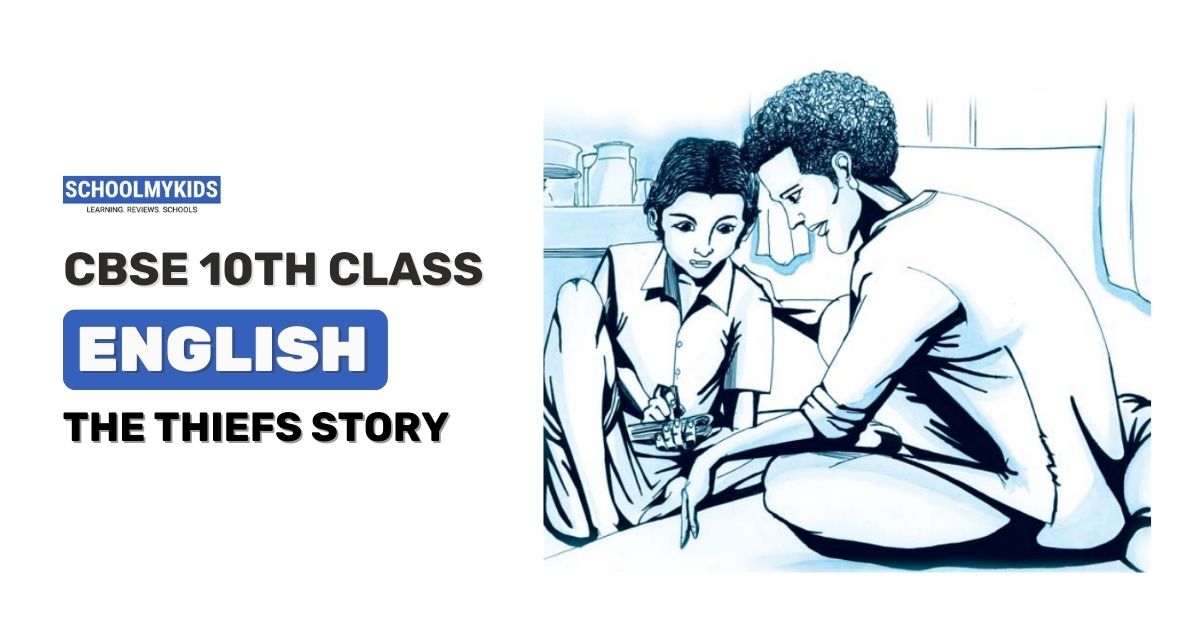“The Thief’s Story” is a chapter from the Class 10 CBSE English textbook, “Footprints without Feet”
Summary
“The Thief’s Story” is a compelling tale by Ruskin Bond, featured in the CBSE 10th board English syllabus. The story revolves around a young boy named Hari Singh, who is a small-time thief. Hari meets Anil, a kind and simple man who makes a living through writing and teaching. Anil, impressed by Hari’s earnest demeanor, takes him in, offering him food and shelter in exchange for simple chores.
Hari Singh sees Anil as an easy target and plans to steal from him. Anil, trusting and unaware of Hari’s intentions, teaches him how to read and write, showing genuine care and affection. Over time, Hari becomes conflicted as he starts to develop a bond with Anil, who treats him with kindness and respect.
One day, Hari Singh steals a bundle of money from Anil and runs away. However, as he roams the streets, he is overcome by guilt and realizes the value of the trust and education Anil has given him. He decides to return the money and resumes his place in Anil’s life, resolved to change his ways. Anil, who realizes what happened but chooses not to confront Hari, continues to treat him with the same kindness and trust, signifying a second chance for the young thief.
Analysis
“The Thief’s Story” is a touching narrative that explores themes of trust, redemption, and the transformative power of kindness. The story highlights how positive human interactions can influence and change a person’s life, leading them towards a better path.
The central theme of the story revolves around the power of trust and kindness in transforming an individual’s life. Anil’s trust in Hari Singh and his willingness to teach him how to read and write play a crucial role in Hari’s transformation. The story underscores the idea that compassion and empathy can lead to profound changes in people.
Ruskin Bond’s simple yet profound storytelling captures the inner conflict of Hari Singh, a young boy torn between his old habits and the new opportunities presented by Anil’s trust. The narrative effectively showcases Hari’s internal struggle and eventual realization of the importance of integrity and trust.
The setting of the story, which shifts from the warmth of Anil’s home to the cold, impersonal streets, symbolizes Hari’s journey from a life of crime to one of honesty and redemption. Bond’s vivid descriptions and character development make the story relatable and impactful.
Important Questions with Explanations
- What is the central theme of “The Thief’s Story”?
- The central theme is the transformative power of trust and kindness. The story highlights how genuine care and empathy can lead to personal redemption.
- Describe Hari Singh’s character at the beginning of the story.
- At the beginning, Hari Singh is a small-time thief who sees Anil as an easy target. He is manipulative and focused on stealing to survive.
- How does Anil influence Hari Singh’s life?
- Anil influences Hari by showing him kindness, trust, and teaching him how to read and write. This positive influence leads Hari to reconsider his ways.
- What internal conflict does Hari Singh experience?
- Hari experiences a conflict between his old habits of stealing and the new sense of trust and responsibility he feels towards Anil.
- Why does Hari Singh decide to return the stolen money?
- Hari returns the stolen money because he feels guilty and realizes the value of the trust and education Anil has given him.
- How does the setting of the story enhance its themes?
- The contrasting settings of Anil’s home and the streets symbolize Hari’s journey from a life of crime to one of honesty and redemption.
- Discuss the role of education in the story.
- Education plays a crucial role as Anil’s efforts to teach Hari how to read and write symbolize the path to a better life and self-improvement.
- What does the story suggest about the nature of trust?
- The story suggests that trust can be a powerful force for change, as Anil’s trust in Hari ultimately leads to his transformation.
- How does Hari’s perception of Anil change throughout the story?
- Initially, Hari sees Anil as a target, but over time he comes to respect and care for him, viewing him as a mentor and a friend.
- What lesson does Hari Singh learn by the end of the story?
- Hari learns the importance of honesty, trust, and the value of genuine human connections.
- Analyze the character of Anil in the story.
- Anil is depicted as kind, trusting, and genuinely interested in helping Hari. His unassuming nature and generosity play a key role in Hari’s transformation.
- What is the significance of Hari Singh’s decision to stay with Anil?
- Hari’s decision to stay signifies his desire to change and his acknowledgment of the positive impact Anil has had on his life.
- How does Ruskin Bond use simplicity in his storytelling?
- Bond uses simple language and straightforward narration to effectively convey deep emotional and moral themes, making the story relatable and impactful.
- What does the stolen money symbolize in the story?
- The stolen money symbolizes Hari’s old life of crime and the temptation to revert to his old ways. Returning it signifies his choice to embrace a better path.
- How does the story explore the theme of redemption?
- The story explores redemption through Hari’s transformation from a thief to a person who values trust and honesty, facilitated by Anil’s kindness.
- What role does empathy play in the story?
- Empathy is central to the story, as Anil’s understanding and non-judgmental approach towards Hari help him see the value of a better life.
- Discuss the significance of the title “The Thief’s Story”.
- The title reflects Hari’s journey and the central focus on his life and transformation, highlighting the impact of Anil’s influence on him.
- How does the story illustrate the impact of positive human interactions?
- The story illustrates that positive human interactions, such as Anil’s kindness and trust, can lead to significant personal growth and change.
- What is the importance of the moment when Hari decides to return the money?
- This moment is pivotal as it marks Hari’s realization of the value of trust and his commitment to change, showing his moral growth.
- What overall message does “The Thief’s Story” convey?
- The overall message is that trust, kindness, and education can lead to redemption and transformation, highlighting the power of positive influence.
Conclusion
“The Thief’s Story” by Ruskin Bond is a touching narrative that explores themes of trust, redemption, and the transformative power of kindness. Through the story of Hari Singh and Anil, Bond conveys the profound impact that empathy and positive human interactions can have on an individual’s life. For students preparing for the CBSE 10th board English exam, understanding this story provides valuable insights into character development, thematic exploration, and narrative techniques, enriching their literary knowledge and analytical skills.









Be the first one to comment on this story.